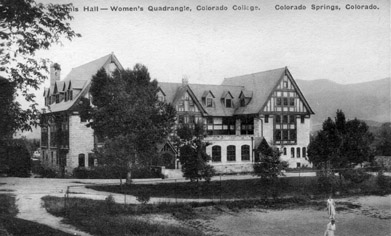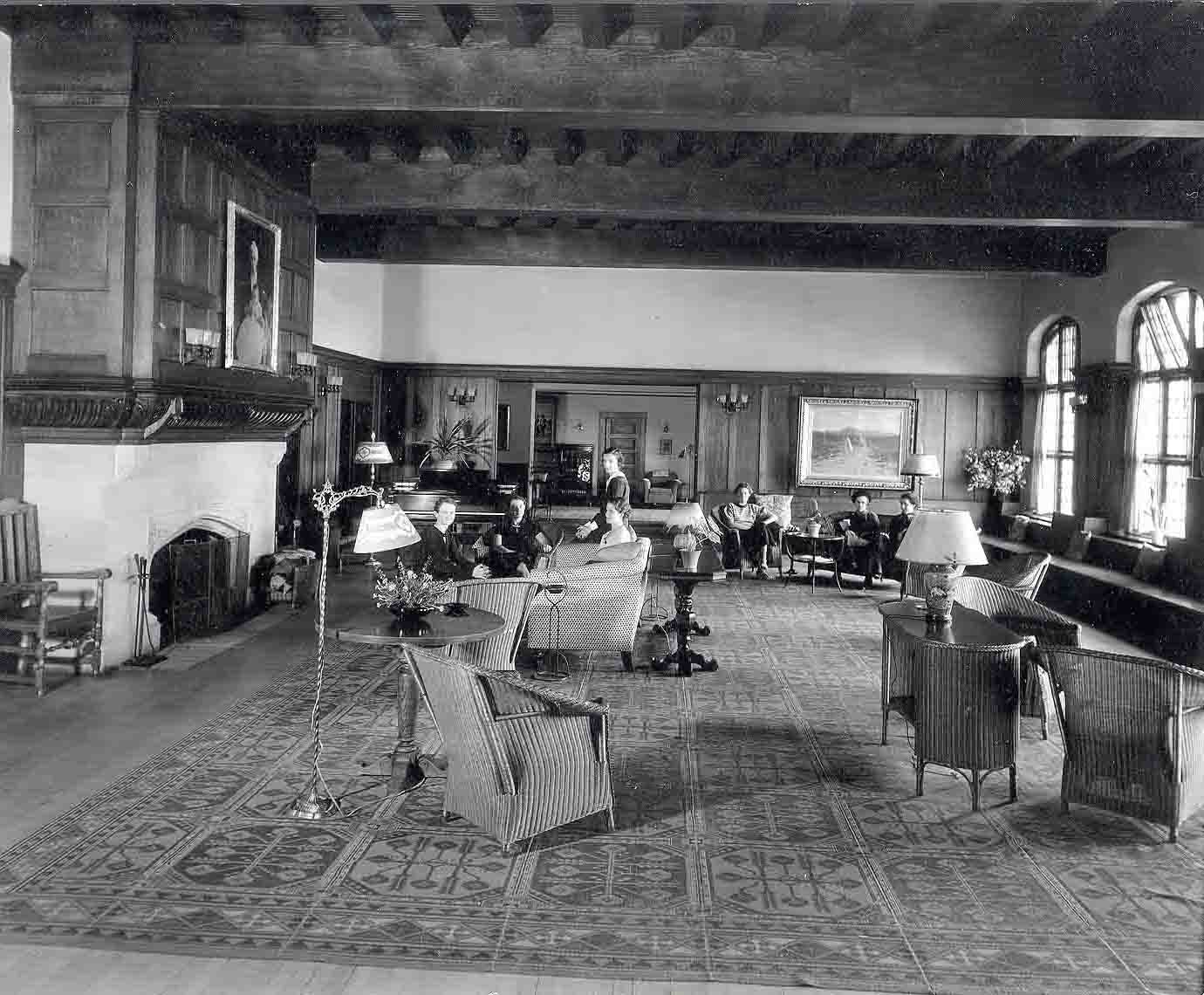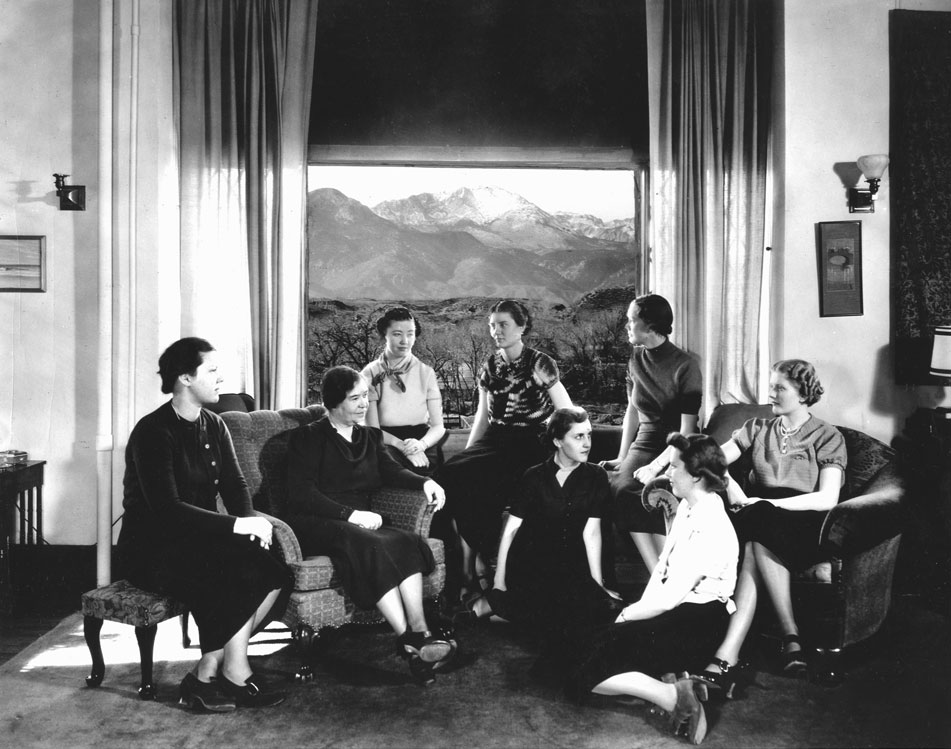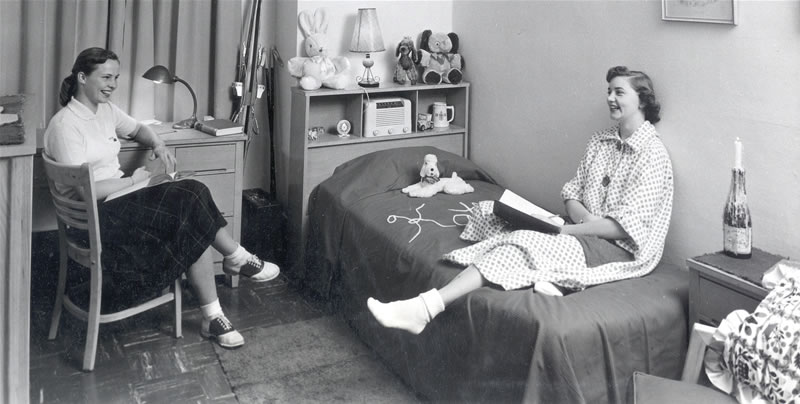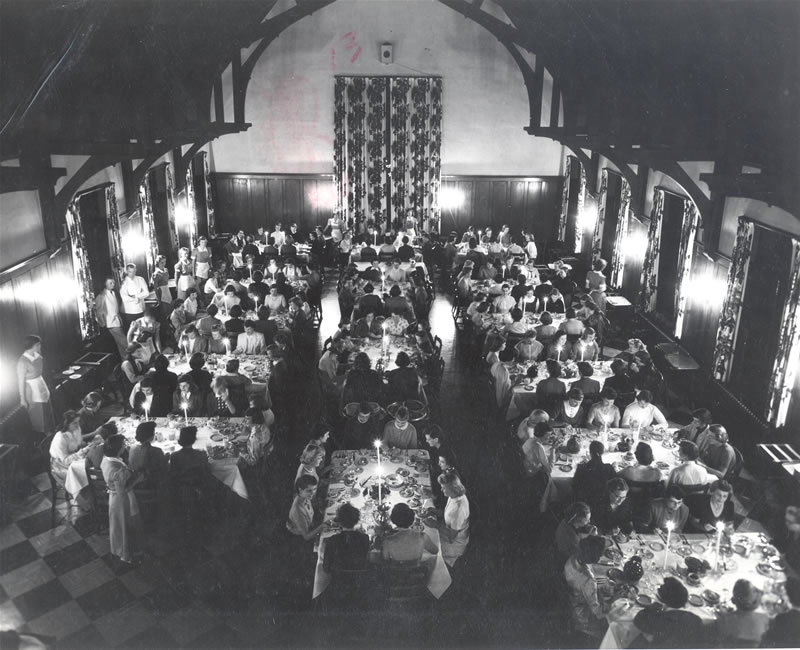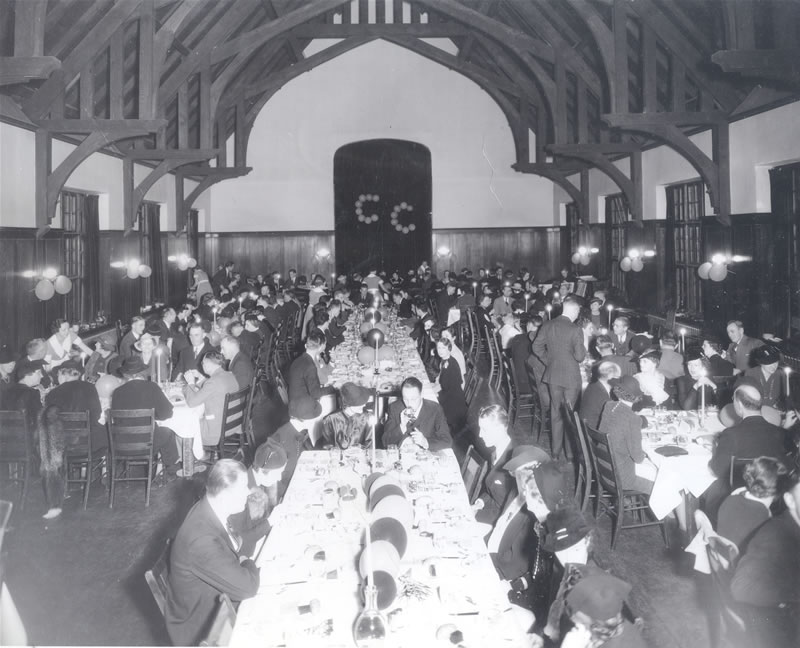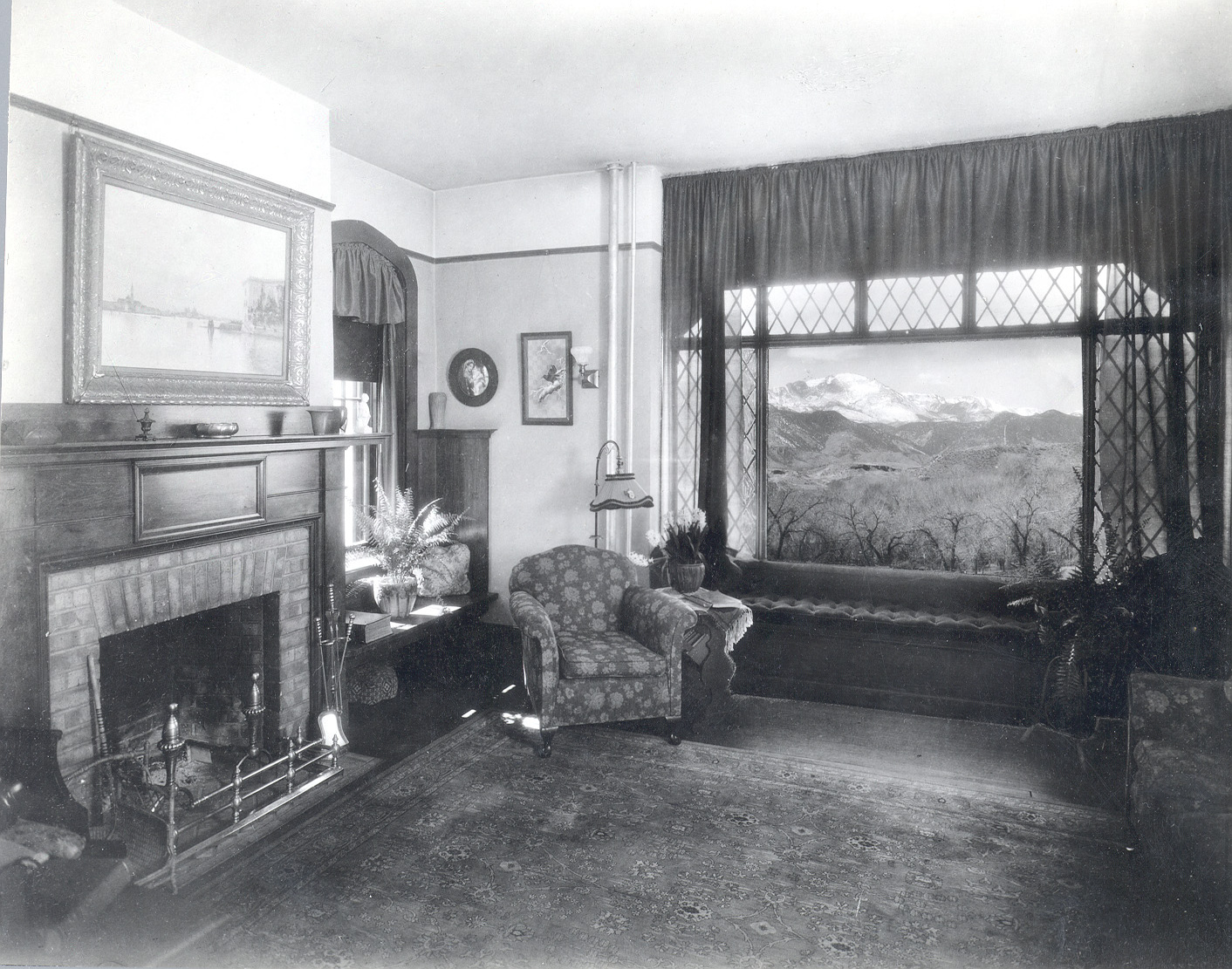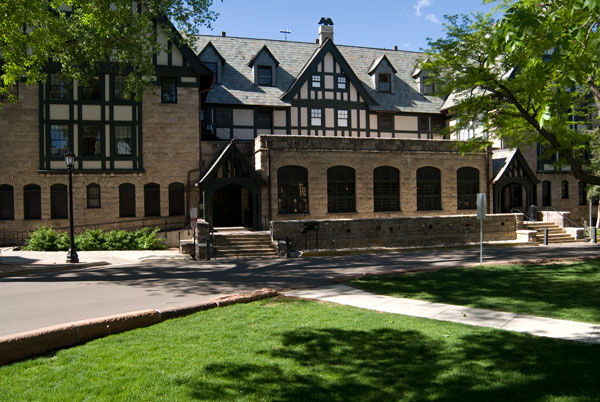Bemis Hall
Tour Stop: #3
Current and Historic Name: Bemis Hall
Address: 920 N. Cascade Avenue
Year Completed: 1908
Architectural Style: Tudor Revival
Architect: Maurice B. Biscoe, Denver
Designation: National Register
Access Level: While Bemis Hall is a residence, the first floor is open to the public. We ask that ongoing activities not be disturbed.
Forming the southern border of the Women's Quadrangle is 1908 Bemis Hall, the fourth and largest of the women's dormitories completed at Colorado College. The Tudor Revival style building features walls of gray Castle Rock rhyolite, a durable building stone also used for the first academic building, Cutler Hall, and the first women's dormitory, Montgomery Hall. Mr. and Mrs. Judson M. Bemis and Colorado Springs founder General William Jackson Palmer provided the principal donations for the $60,000 dormitory. Born in Massachusetts in about 1833, Judson Bemis became wealthy as a manufacturer of cloth and paper bags. The Bemis Brothers Bag Company operated plants in several major American cities and produced a variety of packaging products. In 1881, Bemis moved his family to Colorado Springs seeking health benefits for his wife, Alice Cogswell Bemis. In addition to providing gifts for the college, she was a founder of the Colorado Springs Day Nursery Association and the Woman's Club, and she donated land and money to the YMCA. Judson Bemis served as a college trustee during 1912-18 and provided funds to establish its Department of Business Administration and Banking.
Denver architect Maurice B. Biscoe prepared plans for this building, as well as Cossitt Hall six years later. Biscoe came to Colorado from Boston in 1905 to oversee the construction of Denver's St. John's Cathedral. He established an architectural practice in the capital city, receiving commissions for a number of residences and buildings such as the Dickinson Branch Library and the Clayton School for Boys. In Colorado Springs he also worked on buildings at the Myron Stratton Home. In 1920, Biscoe returned to Boston and joined the firm of Andrews, Rantoul and Jones, which became Andrews, Jones, Biscoe and Whitman in 1925. This firm was the successor to Andrews, Jacques and Rantoul, which had designed 1904 Palmer Hall.
At the dedication ceremony for Bemis, President William F. Slocum observed: "There are great opportunities for good in this building. It is a home for the college student, where the atmosphere is to be that of refinement and cultivation and where the best ideals of a noble life can be realized." The new residents of the hall then welcomed the public to view their dormitory. The Tiger commented, "The girls have spared no effort to make their rooms look as attractive as possible and many exclamations of admiration were heard on all sides." Bemis housed 90 women and featured a medieval-style dining hall with a vaulted ceiling and dark paneled walls, as well as a large common room warmed by a fireplace and furnished by Alice Cogswell Bemis and her daughters. The architect arranged the building with the rooms for public use on the north so that most student rooms had a southern, eastern, or western exposure. The Tiger predicted in future years new buildings would "arise upon the campus, but the type of college hall has now been set for all time."
This Building
in History:
Miss Loomis also told how Dr. Slocum himself fired the heating plant at Montgomery one Sunday early in the fall, when it suddenly turned cold, so that the twenty-five girls in the hall might be comfortable.
By all accounts, Alice Cogswell Bemis was a remarkable woman. She pioneered the course that her daughter was to follow and then carry on to new dimensions.
The office and living quarters of the Dean of Women, located in the southwest corner of the building, included a very large plate glass window providing magnificent views of Pikes Peak and the Rampart Range. Ruth Loomis, who joined the college as the first women's dean in 1897 and held that position until her retirement in 1917, described her negotiations with the architect regarding the design of her quarters in Bemis: "We wanted a great window in the living room of the dean of women which he did not want to give us. He had not been in Colorado long enough then to realize that we never want to be out of sight of mountains. And he only gave us the window under protest."
Miss Loomis, a graduate of Vassar College, regulated the behavior, protected the virtue, and molded the character of the women residing in the residence halls. Mabel Barbee Lee, a graduate and later Dean of Women of Colorado College, recalled that "Dean Loomis felt it was important to give coeds a polish along with strict moral standards . . . She knew all the requirements for proper young women, and lest we forget, a list of reminders was tacked inside our closet doors."
The college carefully regulated the lives of its young women students in the early twentieth century. Curfews were tightly enforced, with Bemis and other dormitories locked each night at 10 p.m. during the week and at midnight on weekends. All social occasions attended by both sexes required the presence of two faculty chaperons. Women were not permitted to smoke or drink on or off campus. Mabel Barbee Lee described the students' irreverent attitude toward Dean Loomis: "She represented the stern disciplinarian to be outwitted, ridiculed, and made the butt of jokes . . . Often, the girls, resentful of restrictions and wanting approval of the boys, poked fun at the dean's admonitions and imitated her eastern accent." Lee recalled male students boosting their dates through the Bemis fire escape windows long after curfew.
Bemis and other women's dormitories surrounded the Women's Quadrangle, a landscaped area with tennis courts that students utilized for a variety of activities, as the Tiger described in 1924:
The first all college serenade in the history of the college was given Friday night. The serenade took place in the quadrangle, and was well received by the C.C. coeds…Art Gow's orchestra furnished the music for the affair. A few of the latest jazz numbers were given by the orchestra. This was followed by 'Colorado C. Men.' All of the fraternities sang one song each … The following fraternity songs were given: 'Sweetheart of Sigma Chi;' 'Dream Girl of Pi Kappa Alpha;' 'Phi Delta Theta for Aye;' 'Kappa Sigma, Queen of Friendship;' 'Fiji Honeymoon;" and 'The Loving Cup.' The Betas did better than the others and managed to produce good harmony. … In addition to the fraternity songs, all the men sang, 'The Black and the Gold' and 'Our Colorado.'
Bemis Hall emerged as the center of social life on the campus, "a place where the men and women of the College can come together under dignified and cultivated conditions," as the Tiger explained. The dining room served three meals a day on tables with "snowy linens and red-shaded lamps" and was large enough to accommodate all the women on campus. At the head of the room the Dean of Women and the senior students occupied a high table. Meal services in the other women's dormitories were discontinued after Bemis opened.
The Cogswell Theater, named in honor of donor Alice Cogswell Bemis, operated in the basement from 1910. For its grand opening on 10 April 1910, the Girl's Dramatic Club presented the play "Title Mart" to an audience composed mostly of male students. The Tiger judged, "The play was a terrific success although some of the cast had not learned their lines." The dramatic group Koshare, headquartered in the theater from about 1929 to 1942, offering a minimum of four staged plays each year. In 1944, Woodson Tyree reactivated the theater and it received a modern radio control room to facilitate radio workshop projects. Later, the theater space was remodeled and served other uses.
In 1956, the college built Taylor Dining Hall on the east side of Bemis. With a capacity for 400 diners, Taylor served women in the dormitory, unaffiliated men, and the faculty. This marked the first time the college allowed students of both sexes to eat meals together on a regular basis. The dining hall employed a full time staff of 18 and 50 part-time student workers. Meals were served on china made exclusively for the college with an orange design on a beige background. The dining hall's name honored the college's first woman trustee, Alice Bemis Taylor, daughter of Judson and Alice Bemis. Taylor, known as "Lady Bountiful" for her generous donations, made substantial contributions and bequests to Colorado College and provided funds for the construction of the Colorado Springs Day Nursery building and the Fine Arts Center. Bemis Hall, still a student residence, was listed in the National Register of Historic Places in 1997 in recognition of its historical and architectural significance.



